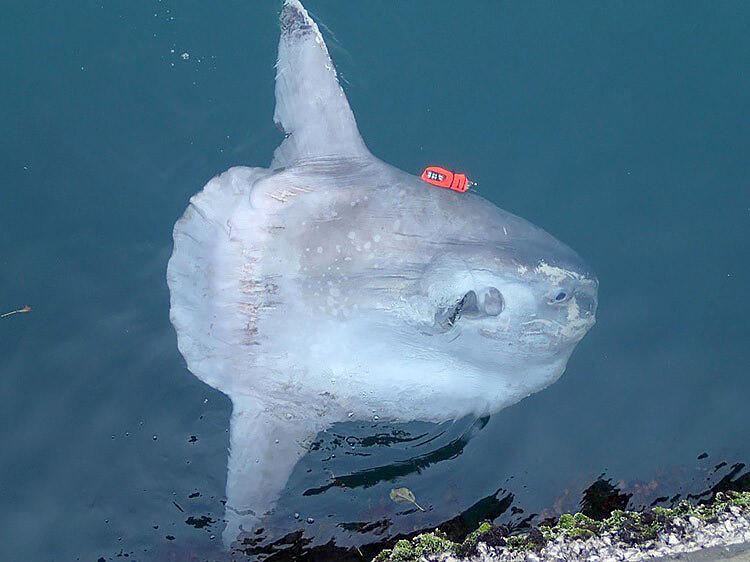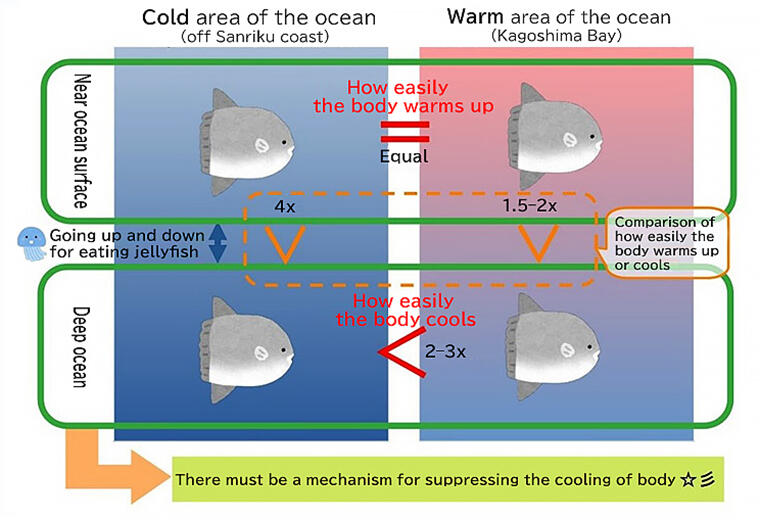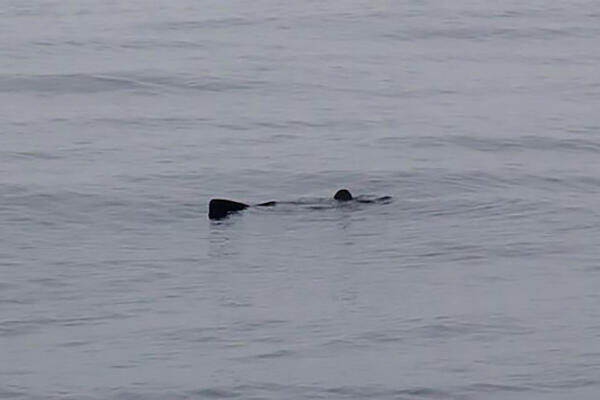The sunfish is an impressive fish that swims slowly. The disparity between its cute shape and its large body may be the secret to its popularity. Research groups, including one group from Nagasaki University, have announced that the sunfish has a mechanism to keep the body cool. In human skin, goose bumps make it difficult for the body's heat to escape when it is cold. The sunfish reportedly has a mechanism that is thought to be equivalent to this. Originally, it was thought that the sunfish has a mechanism to efficiently warm the body near the surface of the sea, but it was found that this was not the case.

(Provided by Nagasaki University Assistant Professor Itsumi Nakamura)
An interesting "nap"
The sunfish is an ectothermic fish that regulates body temperature according to the temperature of the surrounding water, and it selects its environment to maintain an appropriate body temperature. The behavior of lying down on the surface of the sea is known as a "sunfish nap". Six years ago, research group members compiled a paper proposing that this mechanism was employed to warm the body.
Studies at the time found that sunfish off the Sanriku region of Japan traveled from sea level up to depths of 200 m to eat deep-sea jellyfish. By observing changes in the body temperature at this time, it was inferred that after diving down, body temperature recovered while rising to the warm sea surface. It was about four times more likely to change when the body was warm than when it was cold. From this, it seems that after eating food in a cold place, the "nap" allows efficient absorption of heat by some physiological mechanism to warm the body, allowing the sunfish to dive immediately after.
To investigate further, the research group decided to investigate in the warm sea. Three sunfishes raised by Kagoshima City Aquarium (Kagoshima City) were equipped with a water depth, water temperature, and body temperature recording device and a video camera, then released in Kagoshima Bay (Kinko Bay), where the water temperature is high unlike off Sanriku. The water temperature of Kagoshima Bay is said to be approximately 200 m deep and the sea level is about the same as that off Sanriku. Sunfish, like those off Sanriku, frequently moved between sea level and 200 m deep.
Easy to warm and easy to cool
As a result, the sunfish in Kagoshima Bay were 2-3 times warmer than those off Sanriku. In addition, the difference between the ease of warming and the ease of cooling was small. Itsumi Nakamura (Behavioral Ecology) of the research group of Nagasaki University Organization for Marine Science and Technology Institute for East China Sea Research Assistant Professor said, "The sunfish in Kagoshima Bay shouldn't want to warm up, but it's as fast as those off Sanriku. The sunfish off Sanriku should have behaved as if it was 'a quarter of the chilliness' rather than four times the chilliness."
From this, it was concluded that the mechanism of warming in sunfishes is not through an increase in the efficiency of heat absorption on warm sea surfaces, but rather through making it difficult for the body to cool down in cold places. It was found that it has a specific mechanism to suppress the decrease in body temperature, equivalent to the appearance of goose bumps on human skin. Therefore, it is thought that the deep sea, which is rich in food, can be exploited even if it is cold and harsh.

The results were published in the electronic version of the international journal, Experimental Marine Biology and Ecology, on October 30, and announced by Nagasaki University on November 11.
The importance of fish body temperature emerges

(provided by Assistant Professor Nakamura).
So why do sunfishes "nap" ? Professor Nakamura said: "There is no doubt that they are recovering their body temperature. The hypothesis is that in a cold sea like off Sanriku, they may lie down trying to put their whole body in warm water that is only near the surface of the sea. They are not doing anything in their body to activate heat uptake."
Most of the fish are ectothermic, but it seems that there are some fish like this sunfish that do not simply entrust their body temperature to the surrounding water temperature. However, the specific mechanism of sunfish's body temperature maintenance is unknown, and it has become a subject for future research.
Research methods that directly measure body temperature, such as the present one, will lead to a detailed understanding of fish behavior and may be useful for conservation and fishing. Professor Nakamura said, "It has been thought that the body temperature of a general fish would be the same as the water temperature, except for the tuna family, which is noted for its higher body temperature than the water temperature. However, perhaps it is important to examine the behavior of fish from the viewpoint of thermoregulation." The importance of research on body temperature of not only sunfish but also fish in general has "emerged".
Not only the appearance but also the ecology of sunfish is interesting. Although several physiological aspects of this creature remain an enigma, it is expected that further research will improve our understanding of it.
(KUSAKA Takeo / Science Portal Editorial Office)
Original article was provided by the Science Portal and has been translated by Science Japan.




